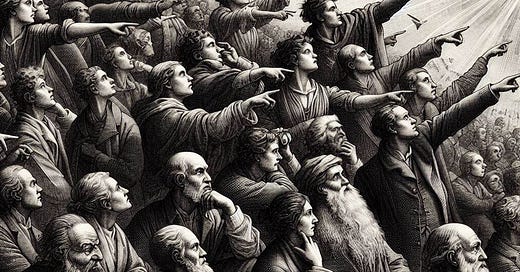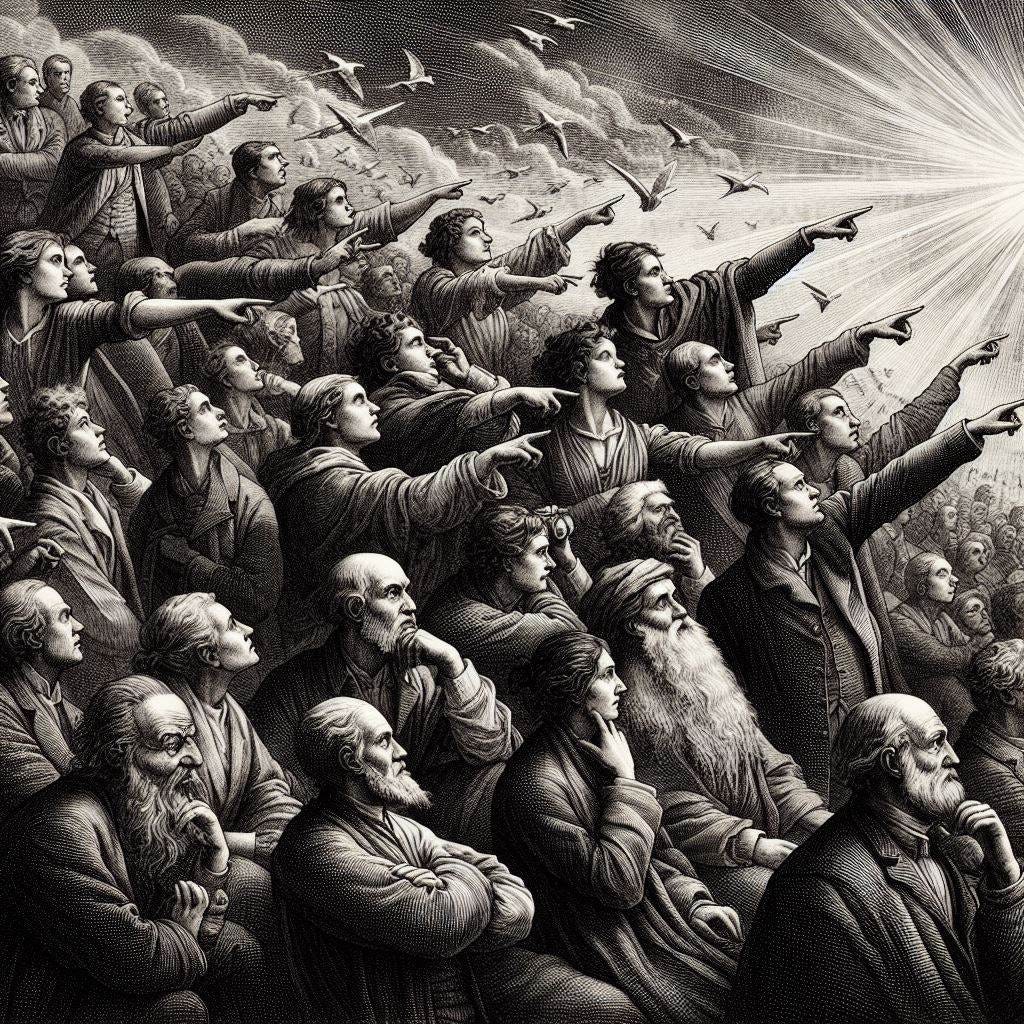Thesis: Social structures materialize as focal points.
If you understand focal points, then you understand society. Of course, there is always more to say. But all statements in human language are inevitably reductionist. Now "society" itself is a reduction to a conceptual form. In other words, we are not looking here at an object beyond a concept, but rather exploring the form and structure of the concept itself. The structure of society, that is, the form of every human relationship, is that of a focal point.
What is a focal point? The idea goes back to David Hume in the form of a "common convention" as a supra-individual imagined interest1, while Thomas Schelling later introduced the concept under this specific name of the “focal point”, sometimes also referred to as a Schelling point2. A focal point refers to an apparently shared tendency to solve a coordination problem among different actors in the absence of direct communication. The concept of tendency needs to be broken down further here: A tendency is created from an expectation about the expectations of other actors that goes back and forth between them, like an imagined mirror image of a mirror image of a mirror image ad infinitum. It is an arbitrarily deeply nested speculation about the speculations of others, which always returns to oneself, whereby it has never actually left one's own mind. A focal point is not an objectively existing fact. Its identity beyond the perceptual boundaries of the individual always remains speculative and therefore metaphysical.
Let us consider two actors (A and B), who can not directly communicate. Actor A expects event E. E could consist of A and B meeting at a certain place at a certain time. And A expects that actor B also expects E. Furthermore, A expects that B expects that A expects E and that A in turn expects this and so on. This recursive loop can be continued indefinitely until actor A is sufficiently certain that A and B expect the same E. But at no time can A be absolutely certain that both actors actually expect E, or even expect the same thing, that the E of A is actually the E of B. But if both actors move and act in this good faith, a common focal point has been established and coordination seems possible, so that they are actually meet. That is, the actual occurrence of event E would be more than just coincidental.
From the perspective of today's mass communication, it may seem strange to formulate a lack of communication as a problem prerequisite. On closer inspection, it turns out to be the problem per se. Language itself is nothing but a plethora of focal points. Every established expression is a focal point. But how can a very first focal point or term be generated at all? Not with the help of other terms, which do not yet exist at the beginning. In other words, you cannot define a first term, i.e. explain a first word with another word. You have to communicate without common expressions. In the end, all communication is based on speculation.
What ignites the very first expectation? If you only wanted to explain a focal point by the fact that it is based on convention instead of direct verbal agreement ("We will meet on ..."), then you are shifting the actual explanation to the concept of convention. You are only introducing a synonym without any further content. A convention is an expected pattern of behavior. A pattern means the recurrence or repetition of the same thing. But why can we hope for recurrence? Why can we expect anything at all?
Because we carry the necessary patterns within ourselves. And we are able to rediscover them. The first reflective puddle of rain paves the way to society. Here we see our own reflection for the first time, we recognize our outer appearance and with this we associate an outer similarity to other human beings and a distance to all other, non-human creatures. A creature that is unable to recognize itself is incapable of forming a society. Every concept is a cut through the world and divides it into two halves. One of the first concepts must be that of the human being, the concept in which we are alike and different from everything else. This common ground is the initial spark that can ignite everything else.
From an external similarity, the speculative conclusion to an inner or mental similarity is not far away. The more similar we appear on the outside, the easier the hope for mutual understanding blossoms. It is the conclusion of one's own sensation of a particular appearing perturbation in the environment (a prominent tree, a distinctive sound, etc.) to the sensation of a person standing next to it. It is the assumption that they perceive the same sound in a similar way, with their similar bodies, with their similarly shaped ears, etc. This makes the speculative cascades described above possible. This idea of meaning the same thing when pointing to the same thing. This is the only meaningful meaning of "meaning": a common interpretation of the supposedly identical object in a common environment. Meaning as a pointing finger, as an arm movement, as the acoustic expression of a first uttered sound that could become a common "word". Meaning is not the content itself, but an indicating movement.
The easier it is to infer an internal similarity from an external one, the more likely and presumably more permanent the formation of a society will be. The segregation of the similar is more likely than the convergence of the different. Of course, the tendency to cross over, to intermingle, to exchange increases at the borders of the different. The boundaries fray naturally, so to speak, which could only be completely prevented by an enormous effort. In this way, however, new variants can emerge that offer new potential for adaptation to the ever-changing environment. On the other hand, a completely arbitrary mixing of everything would be fatal. Life is about maintaining difference and therefore boundaries. A heart can only function as a heart if it sufficiently maintains its structural integrity and thus its demarcation from everything that is not a heart. There is and must be an adherence to structure.
A focal point is established through the realization of an inner commonality. It is a resonance phenomenon. People are capable of resonance in several ways, i.e. they do not just have a single "eigenvalue", a natural frequency on which they are particularly excitable and responsive. Various commonalities can be brought to resonance, but not all of them at the same time to the same extent. This means that some focal points are amplified at the expense of other possible focal points. Hence the great clamor on the political stage. The professional politician is always looking for a specific resonance.
Ultimately, it is about the attention economy. Attention can be attracted through shared fears or hopes and needs. Even if it sounds like a banal insight in the end, the whole political art lies in emphasizing similarity and difference for a particular interest, thereby attracting attention and focusing as much attention as possible on a common point. Focal points are mountains out of molehills. But they are not arbitrary, they need at least some common ground to begin with. A leader is an established focal point of society per se.
David Hume, Enquiry Concerning the Principles of Morals, Appendix III, Paragraph 8
“Thus, two men pull the oars of a boat by common convention for common interest, without any promise or contract; thus gold and silver are made the measures of exchange; thus speech and words and language are fixed by human convention and agreement. Whatever is advantageous to two or more persons, if all perform their part; but what loses all advantage if only one perform, can arise from no other principle There would otherwise be no motive for any one of them to enter into that scheme of conduct.”
Thomas Schelling, The Strategy of Conflict, 1960
“People can often concert their intentions or expectations with others if each knows that the other is trying to do the same. Most situations perhaps every situation for people who are practiced at this kind of game provide some clue for coordinating behavior, some focal point for each person’s expectation of what the other expects him to expect to be expected to do. Finding the key, or rather finding a key - any key that is mutually recognized as the key becomes the key-may depend on imagination more than on logic; it may depend on analogy, precedent, accidental arrangement, symmetry, aesthetic or geometric configuration, casuistic reasoning, and who the parties are and what they know about each other.”



